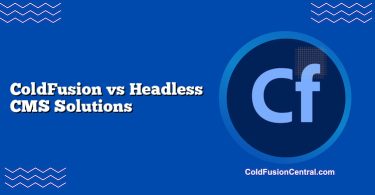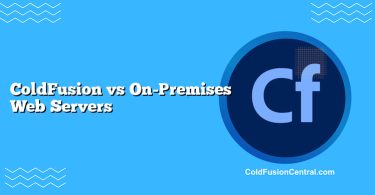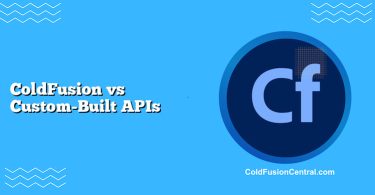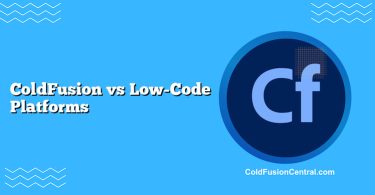Definitions
- ColdFusion (CFML): A rapid application development platform centered around the CFML language, offered commercially as Adobe ColdFusion and as open-source via Lucee. It runs on the JVM and provides a tag-based and script-style syntax with batteries-included features for databases, caching, email, PDF, image processing, and REST APIs.
- JSP (JavaServer Pages): A server-side templating technology in the Java ecosystem (Jakarta EE), where pages are compiled into servlets and executed on a Java servlet container (e.g., Apache Tomcat). JSP commonly uses Expression Language (EL) and JSTL, and it integrates tightly with Java frameworks like Spring MVC.
Overview
ColdFusion and JSP both produce dynamic web content on the JVM, but they differ in philosophy and developer experience.
- ColdFusion focuses on developer productivity and rapid delivery, with a rich standard library, built-in security helpers, and minimal ceremony.
- JSP is a view technology within the broader Java stack, often used alongside servlets, Spring MVC, or other Java web frameworks. It emphasizes flexibility, fine-grained control, and alignment with mainstream Java tools and libraries.
Choose between them by balancing speed of development, budget, team expertise, and long-term architectural goals.
Key Features
ColdFusion (Adobe CF / Lucee CFML)
- Built-in services: caching, task scheduling, PDF generation, email, REST endpoints, web services (SOAP/REST).
- Tag-based and script syntax, easy data access via cfquery and queryExecute.
- ORM integration (Hibernate), image manipulation, file I/O, spreadsheet tools.
- Security helpers (e.g., encodeForHTML, cfqueryparam) and centralized security settings.
- Adobe ColdFusion Enterprise adds clustering, API Manager, and performance monitoring; Lucee offers lightweight, modular alternatives.
JSP (JavaServer Pages)
- Server-side templating compiled to servlets; integrates with JSTL and EL.
- Deep integration with the Java ecosystem: Spring, Hibernate/JPA, Jakarta EE APIs.
- Mature tooling and build systems (Maven/Gradle), testing frameworks (JUnit), and deployment options (Tomcat, Jetty, WildFly).
- Clear separation of concerns when used with MVC frameworks.
- Ideal for teams already invested in Java and enterprise standards.
Side-by-Side Comparison
| Aspect | ColdFusion (CFML) | JSP (JavaServer Pages) |
|---|---|---|
| Performance | Comparable for many workloads; great out-of-the-box features, minimal code overhead. Adobe CF adds accelerators; Lucee is lightweight. | Excellent potential; closer to the metal with servlets. Performance depends on framework, tuning, and architecture. |
| Scalability | Horizontal scaling via multiple CF instances; Adobe Enterprise supports clustering and distributed caching out of the box. | Scales well horizontally with servlet containers; commonly used in enterprise clusters with load balancers and session replication. |
| Learning Curve | Gentle, tag/script syntax; rapid CRUD and integration. | Moderate to steep; JSP is simpler than full Java but typically part of a broader Java stack. |
| Cost | Adobe ColdFusion is licensed (Standard/Enterprise). Lucee is free and open source. | JSP is free and open source; costs arise from app server support and tooling (often optional). |
| Ecosystem | Smaller but active (Lucee, ColdBox). Lots of built-in features reduce dependency on libraries. | Vast Java ecosystem (Spring, Jakarta EE); many libraries and integrations. |
| Security | Built-in sanitizers and DB parameterization; centralized security settings. | Strong security via Spring Security, container-managed auth; more assembly required. |
| Typical Use Cases | Rapid back-office apps, reporting portals, PDF/email-heavy workflows, integration-heavy intranet tools. | Enterprise web apps, high-scale portals, systems benefiting from broader Java libraries and microservices integration. |
| Pros | Fast delivery, batteries included, simpler syntax, Lucee is free, Adobe tooling and enterprise features. | Industry-standard Java tools, strong vendor-neutrality, large talent pool, fine control, modern CI/CD alignment. |
| Cons | Smaller community, perception of niche tech, Adobe licensing costs (if not using Lucee). | JSP as a view is aging; modern Java favors REST + SPA or other templating (Thymeleaf, JSF). More boilerplate. |
Performance
- ColdFusion:
- CFML compiles to Java bytecode. Performance is often very good for CRUD, content rendering, and API endpoints.
- Adobe CF includes performance monitoring and async features; Lucee’s lean runtime can be snappy for micro to mid-sized workloads.
- Built-in features (caching, query of queries, scheduled tasks) can reduce integration latency.
- JSP:
- JSPs are compiled to servlets, benefiting from high JVM performance and JIT optimizations.
- Performance is strongly influenced by architecture (e.g., Spring MVC, caching layers) and JVM tuning.
- For extreme throughput, Java stacks with JSP (or other Java view tech) are well-proven.
Guidance: If you need raw control over threading, I/O, and tuning, Java with JSP (or alternative Java views) offers maximal tuneability. If you want speed-to-value with solid performance, CFML is compelling.
Scalability
- ColdFusion:
- Scales horizontally using multiple CF instances behind a load balancer.
- Adobe CF Enterprise offers built-in clustering, session replication, and distributed caching.
- Lucee can scale in containers (Docker/Kubernetes) with external session/caching stores (Redis, memcached).
- JSP:
- Deployed on servlet containers/app servers (Tomcat, Jetty, WildFly) and scales horizontally well.
- Wide availability of enterprise-grade patterns for clustering, sticky sessions, and session externalization.
- Alignment with cloud-native Java patterns (sidecars, autoscaling, 12-factor apps).
Security
- ColdFusion:
- Security helpers: encodeForHTML/URL/JS, validation functions, script protection settings.
- Database safety via cfqueryparam reduces SQL injection risk by default.
- Adobe CF’s lockdown guides and Secure Profile harden deployments; Lucee promotes least privilege via config.
- JSP:
- Security is typically implemented via frameworks such as Spring Security and container-managed auth.
- JSTL/EL minimize scriptlet usage, reducing risky inline Java.
- More flexibility also means more responsibility to assemble best practices (XSS filters, CSRF tokens, CSP).
Both are secure when configured and coded properly. Security posture depends more on team discipline than on the template technology.
Cost
- ColdFusion:
- Adobe ColdFusion: commercial licenses (Standard/Enterprise). Includes support, performance monitoring, and enterprise features.
- Lucee: free, open source, with optional paid support via third parties.
- Faster time-to-market may reduce development costs.
- JSP:
- JSP and servlet containers are free. Commercial support is optional (e.g., Tomcat support vendors, app server support).
- Larger teams may incur higher dev costs due to more boilerplate and assembly, but benefit from broader talent availability.
Community Support
- ColdFusion:
- Smaller community but active, especially around Lucee and Ortus Solutions (ColdBox, CommandBox).
- Adobe provides enterprise support, updates, and security patches.
- Tutorials, conferences (Into the Box, CF Summit), and Slack/Discourse communities.
- JSP:
- Broad Java community; even if JSP-specific chatter has slowed, Java/Jakarta EE and Spring ecosystems are massive.
- Abundant Q&A, libraries, and integrations; strong CI/CD, containerization, and cloud-native guidance.
Ecosystem and Tooling
- ColdFusion:
- IDEs: VS Code extensions (cfml), Adobe ColdFusion Builder (Eclipse-based).
- CLI: CommandBox for server spooling, package management, and scaffolding.
- Frameworks: ColdBox (MVC), FW/1, Taffy (REST), TestBox (testing).
- JSP:
- IDEs: IntelliJ IDEA, Eclipse, VS Code (with Java extensions).
- Build/CI: Maven, Gradle, Jenkins/GitHub Actions/GitLab CI.
- Frameworks: Spring MVC, Spring Boot, Jakarta EE (Servlet, CDI, JPA), Thymeleaf/JSF as alternatives to JSP.
Supported Platforms
- ColdFusion (Adobe/Lucee):
- OS: Windows, Linux (primary), macOS mainly for development.
- JVM-based; deployable on-prem or cloud; Docker images available (Lucee and Adobe).
- JSP:
- OS: Any platform running Java.
- App servers: Tomcat, Jetty, Undertow, WildFly, Payara; well-supported in containers and Kubernetes.
Language Syntax Differences (Quick Glance)
- ColdFusion (CFML):
- Tag-based: , ,
- Script syntax: cfscript blocks with a JS-like feel
- Example operations: queryExecute(“SELECT …”, params), encodeForHTML(value)
- JSP:
- HTML with EL: ${user.name}
- JSTL tags: ,
- Logic is ideally moved to controllers/servlets; avoid scriptlets in modern practice
Real-World Use Cases
- When ColdFusion shines:
- A mid-sized healthcare provider needs a secure forms portal with PDF generation, scheduled reports, and email notifications. A small team builds it quickly using CFML’s built-in PDF/email features and ORM, deploying on Lucee in Docker. Time-to-market is reduced substantially without assembling many external libraries.
- When JSP shines:
- A financial services firm is expanding a high-traffic online banking portal already built on Spring Boot and Tomcat. JSP is used as a view layer for server-side rendering, leveraging Spring Security, JPA/Hibernate, and message queues (Kafka). The Java stack’s ecosystem, reliability, and scalability fit strict performance and compliance needs.
Development Experience
- ColdFusion:
- Fewer moving parts for common tasks. Developers can deliver features fast with concise syntax and built-ins.
- Helpful for teams without deep Java experience or those focused on business logic over infrastructure.
- JSP:
- Encourages separation of concerns when used with MVC.
- Requires familiarity with the Java toolchain, build systems, and frameworks.
- Fits teams that value strong typing, rigorous testing, and alignment with enterprise standards.
Decision Factors / Which One Should You Choose?
Ask these questions:
- Do you need rapid delivery with minimal boilerplate?
- If yes, consider ColdFusion (Lucee or Adobe).
- Is your organization standardized on Java tooling, Spring, and Jakarta EE?
- If yes, JSP within the Java stack is a natural fit.
- What is your budget model?
- Constrained budget but still want CFML? Use Lucee (free).
- Prefer vendor-backed support and enterprise features out of the box? Adobe ColdFusion fits.
- Want zero runtime licensing and wide skill availability? JSP/Java wins.
- How critical is ultra-high scalability and fine-grained performance tuning?
- For complex, microservice-heavy, or ultra-scale systems, Java/JSP (or other Java view tech) provides maximal flexibility.
- Team skills and hiring:
- Easier to hire Java developers at scale; JSP is familiar if you’re already in Java.
- ColdFusion developers are fewer, but productivity per developer can be very high.
Practical guidance:
- For greenfield enterprise projects on Java stacks, choose JSP only if you truly want server-side rendering; consider modern alternatives like Thymeleaf or a REST-first backend.
- For line-of-business apps, intranets, or reporting systems where speed-to-value matters, CFML (especially Lucee) is a strong contender.
Pros and Cons
ColdFusion (CFML)
Pros:
- Very fast development; rich standard library.
- Easy database access and PDF/email/reporting out of the box.
- Strong security helpers built in.
- Lucee is open-source and lightweight; Adobe offers enterprise support and monitoring.
Cons:
- Smaller community and talent pool.
- Adobe licensing costs (if not using Lucee).
- Perception as niche; some enterprises prefer mainstream Java stacks.
JSP
Pros:
- Part of the broad Java ecosystem; huge library and tool support.
- Good scalability, performance tuning, and deployment patterns.
- Easy integration with Spring, JPA/Hibernate, Jakarta EE.
- Large developer pool and vendor neutrality.
Cons:
- JSP as a server-side view is considered older; many teams prefer Thymeleaf, JSF, or REST + SPA.
- More boilerplate and configuration compared to CFML’s batteries-included approach.
- Security and features require assembling frameworks rather than using built-ins.
Key Takeaways
- Choose ColdFusion (CFML) when you want speed-to-market, built-in features, and minimal configuration. Lucee offers a free path; Adobe CF adds enterprise tooling and support.
- Choose JSP/Java when you need maximum flexibility, integration with Java ecosystems, and long-term scalability within standard enterprise stacks.
- There is no one-size-fits-all: budget, team skills, compliance, and existing infrastructure should drive the decision.
- If you’re already a Java shop, consider modern view layers or REST-first architectures; if you need rapid delivery of data-driven web apps, CFML is hard to beat.
FAQ
What’s the difference between Adobe ColdFusion and Lucee?
Adobe ColdFusion is the commercial CFML engine with enterprise features, official support, and bundled tooling. Lucee is a free, open-source CFML engine that is lightweight and popular for modern deployments. Both execute CFML on the JVM, but feature sets and licensing differ.
Is JSP still relevant, or should I use Thymeleaf/JSF instead?
JSP remains supported and works fine, especially in legacy or incremental upgrades. However, many modern Java applications prefer Thymeleaf or JSF for server-side rendering, or they expose REST APIs and use a front-end framework. Your choice should match your architecture and team skills.
Which option is more secure: ColdFusion or JSP?
Both can be highly secure if implemented correctly. ColdFusion offers built-in security helpers and centralized settings; JSP typically relies on frameworks like Spring Security and container-managed auth. Security outcomes depend on coding practices, configuration, and patching cadence.
Can I containerize and deploy either option to Kubernetes?
Yes. Both ColdFusion (Adobe/Lucee) and JSP apps run on the JVM and can be packaged with Docker and orchestrated via Kubernetes. Use health checks, externalized sessions, and observability (Prometheus/OpenTelemetry) for robust deployments.
How do costs compare over time?
JSP has no runtime licensing fees; costs are mainly development, hosting, and optional support. ColdFusion with Adobe involves licensing but may reduce development time and integration costs. Lucee offers the no-license path for CFML, potentially balancing productivity and cost effectiveness.




